Code
import pandas as pd
import numpy as np
import matplotlib.pyplot as plt
plt.rcParams['figure.figsize'] = (10, 5)kakamana
January 18, 2023
We will discover the conceptual framework behind logistic regression and SVMs. This will let us delve deeper into the inner workings of these models.
This Logistic regression is part of Datacamp course: Linear Classifiers in Python
This is my learning experience of data science through DataCamp
Earlier we used logistic regression on the handwritten digits data set. Here, we’ll explore the effect of L2 regularization. The handwritten digits dataset is already loaded, split, and stored in the variables X_train, y_train, X_valid, and y_valid. The variables train_errs and valid_errs are already initialized as empty lists.
# Train and validation errors initialized as empty list
train_errs = list()
valid_errs = list()
# Loop over values of C_value
C_values = [0.001, 0.01, 0.1, 1, 10, 100, 1000]
for C_value in C_values:
# Create LogisticRegression object and fit
lr = LogisticRegression(C=C_value, max_iter=10000)
lr.fit(X_train, y_train)
# Evalueate error rates and append to lists
train_errs.append(1.0 - lr.score(X_train, y_train))
valid_errs.append(1.0 - lr.score(X_valid, y_valid))
# Plot results
plt.semilogx(C_values, train_errs, C_values, valid_errs);
plt.ylabel('classification error')
plt.xlabel('C (Inverse regularization strength)')
plt.legend(("train", "validation"));
print("\nAs you can see, too much regularization (small C) doesn’t work well – due to underfitting – and too little regularization (large C) doesn’t work well either – due to overfitting.")
As you can see, too much regularization (small C) doesn’t work well – due to underfitting – and too little regularization (large C) doesn’t work well either – due to overfitting.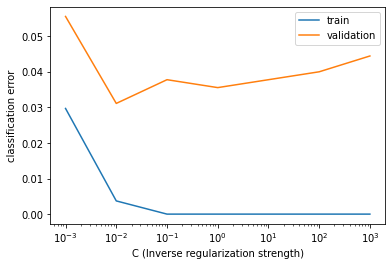
In this exercise we’ll perform feature selection on the movie review sentiment data set using L1 regularization. The features and targets are already loaded for you in X_train and y_train.
We’ll search for the best value of C using scikit-learn’s GridSearchCV(), which was covered in the prerequisite course.
from sklearn.model_selection import GridSearchCV
# Specify L1 regularization
lr = LogisticRegression(penalty='l1', solver='liblinear')
# Instantiate the GridSearchCV object and run the search
searcher = GridSearchCV(lr, {'C':[0.001, 0.01, 0.1, 1, 10]})
searcher.fit(X_train, y_train)
# Report the best parameters
print("Best CV params", searcher.best_params_)
# Find the number of nonzero coefficients (select features)
best_lr = searcher.best_estimator_
coefs = best_lr.coef_
print("Total number of features:", coefs.size)
print("Number of selected features:", np.count_nonzero(coefs))Best CV params {'C': 0.1}
Total number of features: 89527
Number of selected features: 1106In this exercise we’ll try to interpret the coefficients of a logistic regression fit on the movie review sentiment dataset. The model object is already instantiated and fit for you in the variable lr.
In addition, the words corresponding to the different features are loaded into the variable vocab. For example, since vocab[100] is “think”, that means feature 100 corresponds to the number of times the word “think” appeared in that movie review.
LogisticRegression(multi_class='ovr', n_jobs=1, solver='liblinear')In a Jupyter environment, please rerun this cell to show the HTML representation or trust the notebook.
LogisticRegression(multi_class='ovr', n_jobs=1, solver='liblinear')
Most positive words: ['excellent'], ['refreshing'], ['wonderfully'], ['perfect'], ['superb'],
Most negative words: ['waste'], ['worst'], ['disappointment'], ['poorly'], ['awful'],
In this exercise, you will observe the effects of changing the regularization strength on the predicted probabilities.
def make_meshgrid(x, y, h=.02, lims=None):
"""Create a mesh of points to plot in
Parameters
----------
x: data to base x-axis meshgrid on
y: data to base y-axis meshgrid on
h: stepsize for meshgrid, optional
Returns
-------
xx, yy : ndarray
"""
if lims is None:
x_min, x_max = x.min() - 1, x.max() + 1
y_min, y_max = y.min() - 1, y.max() + 1
else:
x_min, x_max, y_min, y_max = lims
xx, yy = np.meshgrid(np.arange(x_min, x_max, h),
np.arange(y_min, y_max, h))
return xx, yy
def plot_contours(ax, clf, xx, yy, proba=False, **params):
"""Plot the decision boundaries for a classifier.
Parameters
----------
ax: matplotlib axes object
clf: a classifier
xx: meshgrid ndarray
yy: meshgrid ndarray
params: dictionary of params to pass to contourf, optional
"""
if proba:
Z = clf.predict_proba(np.c_[xx.ravel(), yy.ravel()])[:,-1]
Z = Z.reshape(xx.shape)
out = ax.imshow(Z,extent=(np.min(xx), np.max(xx), np.min(yy), np.max(yy)),
origin='lower', vmin=0, vmax=1, **params)
ax.contour(xx, yy, Z, levels=[0.5])
else:
Z = clf.predict(np.c_[xx.ravel(), yy.ravel()])
Z = Z.reshape(xx.shape)
out = ax.contourf(xx, yy, Z, **params)
return out
def plot_classifier(X, y, clf, ax=None, ticks=False, proba=False, lims=None):
# assumes classifier "clf" is already fit
X0, X1 = X[:, 0], X[:, 1]
xx, yy = make_meshgrid(X0, X1, lims=lims)
if ax is None:
plt.figure()
ax = plt.gca()
show = True
else:
show = False
# can abstract some of this into a higher-level function for learners to call
cs = plot_contours(ax, clf, xx, yy, cmap=plt.cm.coolwarm, alpha=0.8, proba=proba)
if proba:
cbar = plt.colorbar(cs)
cbar.ax.set_ylabel('probability of red $\Delta$ class', fontsize=20, rotation=270, labelpad=30)
cbar.ax.tick_params(labelsize=14)
#ax.scatter(X0, X1, c=y, cmap=plt.cm.coolwarm, s=30, edgecolors=\'k\', linewidth=1)
labels = np.unique(y)
if len(labels) == 2:
ax.scatter(X0[y==labels[0]], X1[y==labels[0]], cmap=plt.cm.coolwarm,
s=60, c='b', marker='o', edgecolors='k')
ax.scatter(X0[y==labels[1]], X1[y==labels[1]], cmap=plt.cm.coolwarm,
s=60, c='r', marker='^', edgecolors='k')
else:
ax.scatter(X0, X1, c=y, cmap=plt.cm.coolwarm, s=50, edgecolors='k', linewidth=1)
ax.set_xlim(xx.min(), xx.max())
ax.set_ylim(yy.min(), yy.max())
# ax.set_xlabel(data.feature_names[0])
# ax.set_ylabel(data.feature_names[1])
if ticks:
ax.set_xticks(())
ax.set_yticks(())
# ax.set_title(title)
if show:
plt.show()
else:
return ax
Maximum predicted probability 0.9973143426900802# Set the regularization strength
model = LogisticRegression(C=0.1)
# Fit and plot
model.fit(X, y)
plot_classifier(X, y, model, proba=True)
# Predict probabilities on training points
prob = model.predict_proba(X)
print("Maximum predicted probabilty", np.max(prob))
print("\nAs you probably noticed, smaller values of C lead to less confident predictions. That's because smaller C means more regularization, which in turn means smaller coefficients, which means raw model outputs closer to zero and, thus, probabilities closer to 0.5 after the raw model output is squashed through the sigmoid function. That's quite a chain of events!")
Maximum predicted probabilty 0.9352061680350907
As you probably noticed, smaller values of C lead to less confident predictions. That's because smaller C means more regularization, which in turn means smaller coefficients, which means raw model outputs closer to zero and, thus, probabilities closer to 0.5 after the raw model output is squashed through the sigmoid function. That's quite a chain of events!We’ll visualize the examples that the logistic regression model is most and least confident about by looking at the largest and smallest predicted probabilities.
def show_digit(i, lr=None):
plt.imshow(np.reshape(X[i], (8,8)), cmap='gray',
vmin = 0, vmax = 16, interpolation=None)
plt.xticks(())
plt.yticks(())
if lr is None:
plt.title("class label = %d" % y[i])
else:
pred = lr.predict(X[i][None])
pred_prob = lr.predict_proba(X[i][None])[0,pred]
plt.title("label=%d, prediction=%d, proba=%.2f" % (y[i], pred, pred_prob))
plt.show()lr = LogisticRegression(max_iter=10000)
lr.fit(X, y)
# Get predicted probabilties
proba = lr.predict_proba(X)
# Sort the example indices by their maximum probabilty
proba_inds = np.argsort(np.max(proba, axis=1))
# Show the most confident (least ambiguous) digit
show_digit(proba_inds[-1], lr)
# Show the least confident (most ambiguous) digit
show_digit(proba_inds[0], lr)
print("\nAs you can see, the least confident example looks like a weird 9, and the most confident example looks like a very typical 5")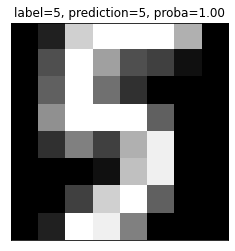
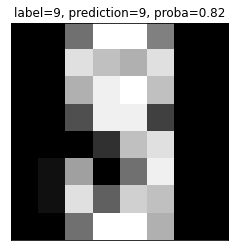
As you can see, the least confident example looks like a weird 9, and the most confident example looks like a very typical 5If you fit a logistic regression model on a classification problem with 3 classes and 100 features, how many coefficients would you have, including intercepts?
303
100 coefficients + 1 intercept for each binary classifier. (A, B), (B, C), (C, A) 101 * 3 = 303
We’ll fit the two types of multi-class logistic regression, one-vs-rest and softmax/multinomial, on the handwritten digits data set and compare the results.
# Fit one-vs-rest logistic regression classifier
lr_ovr = LogisticRegression(multi_class='ovr',max_iter=10000)
lr_ovr.fit(X_train, y_train)
print("OVR training accuracy:", lr_ovr.score(X_train, y_train))
print("OVR test accuracy:", lr_ovr.score(X_test, y_test))
# Fit softmax classifier
lr_mn = LogisticRegression(multi_class='multinomial', solver='lbfgs', max_iter=10000)
lr_mn.fit(X_train, y_train)
print("Softmax training accuracy:", lr_mn.score(X_train, y_train))
print("Softmax test accuracy:", lr_mn.score(X_test, y_test))
print("\nthe accuracies of the two methods are fairly similar on this data set.")OVR training accuracy: 0.9985152190051967
OVR test accuracy: 0.9511111111111111
Softmax training accuracy: 1.0
Softmax test accuracy: 0.9622222222222222
the accuracies of the two methods are fairly similar on this data set.We’ll continue with the two types of multi-class logistic regression, but on a toy 2D data set specifically designed to break the one-vs-rest scheme.
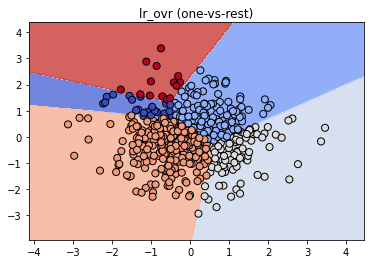
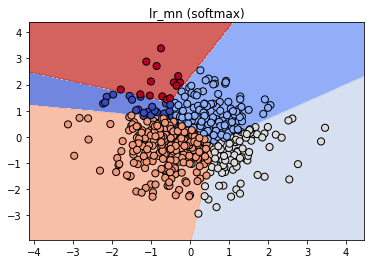
print("Softmax training accuracy:", lr_mn.score(X_train, y_train))
print("One-vs-rest training accuracy:", lr_ovr.score(X_train, y_train))
# Create the binary classifier (class 1 vs. rest)
lr_class_1 = LogisticRegression(max_iter=10000, C=100)
lr_class_1.fit(X_train, y_train == 1)
# Plot the binary classifier (class 1 vs. rest)
plot_classifier(X_train, y_train == 1, lr_class_1);
print("\nthe binary classifier incorrectly labels almost all points in class 1 (shown as red triangles in the final plot)! Thus, this classifier is not a very effective component of the one-vs-rest classifier. In general, though, one-vs-rest often works well.")Softmax training accuracy: 0.952
One-vs-rest training accuracy: 0.996
the binary classifier incorrectly labels almost all points in class 1 (shown as red triangles in the final plot)! Thus, this classifier is not a very effective component of the one-vs-rest classifier. In general, though, one-vs-rest often works well.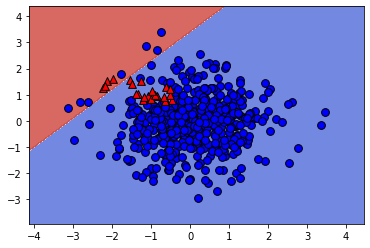
As motivation for the next and final chapter on support vector machines, we’ll repeat the previous exercise with a non-linear SVM. Once again, the data is loaded into X_train, y_train, X_test, and y_test .
Instead of using LinearSVC, we’ll now use scikit-learn’s SVC object, which is a non-linear “kernel” SVM. Again, your task is to create a plot of the binary classifier for class 1 vs. rest.
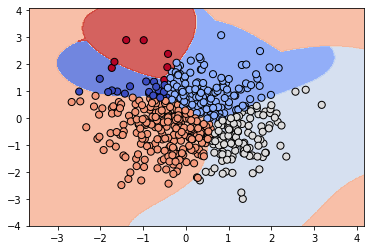
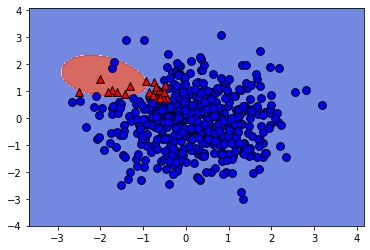
The non-linear SVM works fine with one-vs-rest on this dataset because it learns to "surround" class 1